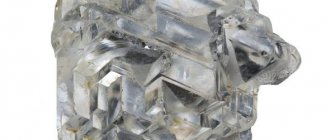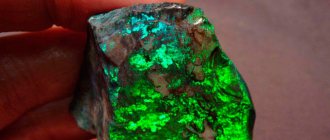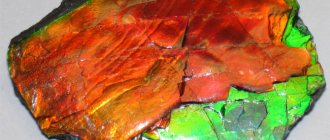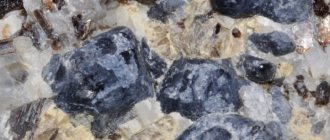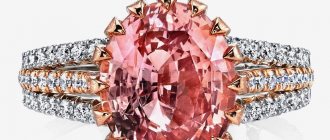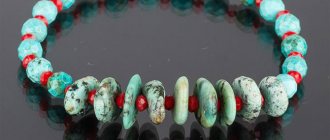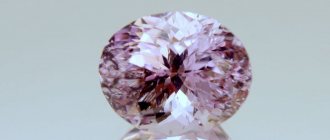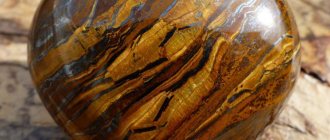| Category | Oxides (minerals) |
| Title in English | Alexandrite |
| Formula | Al2BeO4 |
| Group | Chrysoberyl group |
| Color | Dark blue-green, Bluish green, Dark grass green, Olive green, Rose-raspberry, Red-violet, Purple |
| Stroke color | White |
| Shine | Glass |
| Transparency | Transparent, translucent |
| singonia | Rhombic |
| Hardness | 8,5 |
| Cleavage | Imperfect |
| Density, g/cm³ | 3.5 - 3.84 g/cm³ |
| Kink | Conchoidal |
| origin of name | The first alexandrite mineral was found in the Urals in 1833. The story goes that a year later the stone was presented as a gift to Tsar Alexander II himself. Thus, alexandrite got its name in honor of the Russian Tsar. |
| Morphology | Alexandrite has a toasty-tabular and sometimes short-prismatic appearance of crystals. In addition, the short-prismatic appearance can be characterized by a combination of pinacoids (100) and (010), as well as prisms (011) and (120). |
Alexandrite is a variety of chrysoberyl that contains an admixture of chromium. The mineral was described in the mid-19th century. Its characteristic difference from similar gems is its strong pleochroism. A proverb about the mineral says “in the morning - emerald, in the evening - ruby.” In sunlight, alexandrite is bright green, and in electric light it is rich red.
Story
Even in ancient times, humanity was familiar with this precious stone. In the ancient Indian epic "Mahabharata" it (or ordinary chrysoberyl) was called the "peacock's eye".
There are two approximately equal in probability versions of the discovery of alexandrite.
Nils Nordenskiöld, a Finnish mineralogist, discovered a strange stone in the Ural Mountains in 1834. At first he thought that this was a suspiciously strong emerald of not the first purity, but in the light of the lamp the green gem turned into a crimson “ruby”. Soon the scientist named the amazing find in honor of Alexander II, who at that time was celebrating his coming of age (at that time, from the age of 16 a person was considered an adult).
There is another discoverer - Yakov Kokovin, who sent a sample of emerald found in 1833 to St. Petersburg. The Minister of Appanages, Lev Perovsky, took up the study of the specimen, and later gave the unusual find to the future Emperor Alexander II as a gift for his coming of age. As a result, the stone named after the tsar became his personal talisman, and, perhaps, it was he who protected him in difficult times for Russia.
In the Russian Empire, the stone was highly valued and worn only by noble people (green and red are the traditional colors of the nobility), so it was more expensive than some diamonds. Only after the First World War did alexandrite gain fame as a “widow’s stone”, because it was owned by noblewomen whose husbands did not return from the battlefield. Alexandrite then began to be associated with pain and loss.
Since the announcement of the discovery of the stone in 1842, alexandrite has long been called the “original Russian stone,” but towards the end of the 20th century, after the discovery of new foreign deposits, the mineral ceased to have a patriotic connotation.
Brazilian crystal passion color
Mining of alexandrite in Brazil began at the end of the last century. The deposit was located in a place called Hematita. The discovered mine turned out to be poor, and therefore its active development lasted only for six months. During this period, it was possible to obtain about 260 thousand carats of rough gems. Nowadays small accumulations of the precious mineral can only occasionally be found there.
Brazilian alexandrite (like African alexandrite) shows a red-burgundy color in artificial evening light. During the day it takes on its natural brownish-green hue. In addition, crystals found in Brazil are often larger than gems sourced from other countries.
Nowadays, the stone is mined in the state of Minas Gerais in parallel with other valuable minerals. The production takes place in pegmatites - igneous rock consisting of large crystals. The mines of Brazil are equipped with the latest technology, but even here alexandrite can be rarely found. It is worth its weight in gold.
Production
The first and one of the largest deposits of alexandrite is the Malyshevskoye deposit, located in the Ural Mountains. In addition, this mineral is mined in Sri Lanka, Madagascar, India and Tanzania. Brazil also used to have a deposit, but it was soon depleted.
Alexandrite is a rare gem. Even in the large Malyshevsky deposit, among the tons of processed rock there is only one hundred grams of the mineral. For this reason, the “imperial stone” is very expensive, and not everyone can afford it.
A deposit known throughout the world
“Emerald Mines of the Urals” is a legendary name. Also known is the Mariinsky mine, which was later renamed Malyshevsky. It still works today, only it now belongs to the Kaliningrad Amber Factory. Alexandrites have not been mined here for a long time, only emeralds and beryl.
Some gems discovered at the Malyshevskoye deposit are known far beyond the borders of our country. For example, “Druze Kochubey”. Druses are minerals fused and adhered to one base. The size of this Ural find is 22x13 cm. It is formed by dark green crystals measuring 6x6 cm. The storage location of the “Druze of Kochubey” is the Mineralogical Museum named after A.E. Fersman.
The largest single alexandrite crystal was discovered in the same deposit in the Urals. After jewelry processing, its weight was almost 523 carats.
By the way, in addition to Malyshevsky there is the Krasnobolotsky mine, located not far from the first one. Alexandrites of the highest quality have also been mined there for a long time.
Features of the mineral
Alexandrite (chemical formula – Al2BeO4) is a type of chrysoberyl with an admixture of chromium.
Chrysoberyl, despite its name, is not a type of beryl, which includes aquamarine, emerald, morganite and others. The famous feature of the “widow’s stone” is pleochroism (from the ancient Greek “many colors”). An unusual stone, like a chameleon, changes its color: green under sunlight, purple or red under electric light. Other minerals (aquamarine, tourmaline, zircon) also have pleochroism, but it is in alexandrite that this quality is most clearly expressed. This feature is explained by the presence of chromium, the atoms of which are “sewn” into the structure of the mineral.
The amazing properties of the alexandrite stone do not end with the color reverse:
- Hardness 8.5 on the Mohs scale;
- Glass shine;
- The stone can be transparent or translucent;
- The fracture is conchoidal;
- Cleavage is imperfect;
- Density 3.5-3.84 g/cm3.
Stone color variations
Alexandrite is unique in its ability to change color. Under the rays of the sun, the mineral takes on green, olive or bluish shades, and under artificial lighting it turns into a pink, purple or red stone. Under some other lamps, alexandrite even turns yellow.
There are three varieties of alexandrite:
- Ural stones are the highest quality stones with the most clearly defined pleochroism;
- African and Brazilian - duller with a less pronounced color reverse effect;
- From the island of Sri Lanka - unique alexandrites with opalescence and a “cat’s eye” effect.
Cut
In the photo: alexandrite with a high-quality octagon cut in different lighting, 5.80 carats
The shape and quality of the cut is also an important factor. For natural alexandrites, the oval cut is especially popular. But, of course, there are faceted alexandrites of other shapes. The proportions of the inclination of the angles of the edges must be such that the stone is bright and does not have an edge, i.e. a light area through which the color “flows”. It happens that Asian cutters try to “pull out” more mass in the finished stone when cutting, and they make “pulled” pavilions (the lower part of the stone). Alexandrites that are opaque or of low purity are used to make cabochons. For both cut stones and cabochons, it is important to have symmetry, correct proportions and good polishing.
“ Practical advice. Evaluate the attractiveness of the shape and the overall quality of the cut. Pay attention to the symmetry of the stone, whether there is a “window” in the stone, and how much it affects the beauty. Isn't the pavilion too long? Look at the quality of polishing, the absence of marks, scratches and chips on the surface of the stone. Many not very serious surface defects can easily be eliminated by recutting, which is quite inexpensive.”
Properties
Magical
Alexandrite is a stone of people who love to change their lives and put it at risk. It attracts good luck, prosperity in love affairs, and inspiration. The stone lifts the mood, enhances the owner’s emotions, and increases creativity. The "Widow's Stone" is associated with the other world and has the ability to predict the future. If your jewelry suddenly turns red in daylight, this indicates that the owner will experience something related to blood loss, injury or injury. If alexandrite takes on a golden hue, then it warns of a dangerous life situation.
Alexandrite brings its owner a stormy life and risk, so only a strong person who knows how to control himself will receive a reward after all the trials. This stone is not suitable for peaceful, quiet, calm people who do not like change.
Healing
The main “specialization” of alexandrite is the circulatory system. The main colors of alexandrite - green and red - symbolize two types of blood - venous and arterial. This stone strengthens the walls of blood vessels, maintains normal heartbeat and blood pressure, treats diseases of the blood vessels, and prevents the formation of blood clots.
Alexandrite also improves the functioning of the gastrointestinal tract and calms the nervous system. Water infused with alexandrite also helps treat alcoholism, dulling the craving for alcohol.
Alexandrite is best worn during the day, and at night the gem should rest.
Magical and healing properties of alexandrite
Since its discovery, alexandrite has been credited with strong magical powers. It was considered a soothsaying stone, and a change in color was associated with a harbinger of trouble or illness. For Europeans, the changeability of alexandrite was a symbol of two extremes of love: passion and jealousy.
Advertising - Continued below
In Rus', alexandrite stone was considered a widow's stone: after the assassination of the Tsar and the end of the war, rich widows began to wear it as a sign of the loss of a loved one.
The influence of alexandrite on a person’s fate is ambiguous; it can subjugate a weak person and destroy his life, while he endows a strong person, capable of overcoming adversity, with courage and bravery.
Ancient healers saw alexandrite as a reflection of the circulatory system; blue meant venous blood, red meant arterial blood. They used this stone to treat the heart, blood vessels, cleanse the blood, and also as a hemostatic agent.
Advertising - Continued below
Stone and zodiac circle
Alexandrite is a stone of the water element, with its iridescence personifying the impermanence of the forms of water. It is ruled by Saturn and is recommended for anyone who is willing to take risks and achieve more out of life. The stone brings good luck, inspiration, creative powers to most zodiac signs; even the quiet Pisces will be favored by the stone.
It is not recommended to wear it only for Cancers, Virgos and Taurus, because not every representative of such a sign will withstand the changes caused by the stone. Sagittarius and Aries need to wear alexandrite with caution, as it can make the energy of these signs wild and untamed.
When purchasing alexandrite, it is important to focus on your own feelings. If it suits your horoscope, but something inside is against it, then it’s better not to buy it.
How to distinguish from a fake
It is logical to assume that the magical and healing abilities of the stone will only work if the stone is real and not counterfeit. Due to the fact that alexandrite is rarely found in nature, imitations made from garnet, corundum or simple glass can often be sold on the market for huge sums of money. There is nothing wrong with these minerals (except glass), but if alexandrite is what you need, then it is better to avoid unnecessary disappointment and expense.
In fact, it is quite difficult to determine which stone is real, so it is better to check it in the laboratory and ask a specialist for help. You shouldn’t order a stone online yet, because it’s difficult to identify an alexandrite stone from just one photo.
The main signs of a counterfeit stone:
- The size is too large, because specimens with a diameter of 6 millimeters are extremely rare;
- The seller does not have a certificate of authenticity of the gem;
- There are very few antique jewelry, so if you are offered “antique” jewelry with alexandrite, you should be wary;
- The glass fake does not have the effect of pleochroism, it just sparkles with an iridescent sheen, and also does not have the strength characteristic of alexandrite;
- A synthetic crystal will have crystal transparency and spherical bubbles inside (in alexandrite they have the shape of drops);
- If alexandrite turns yellow rather than red under artificial light, then it is artificial corundum;
- Andalusite also has pleochroism, but under a certain view a rainbow shine appears, which is absent in a real stone;
- Imitation spinel under artificial light will turn purple rather than red.
How to care for alexandrite
When wearing alexandrite jewelry, it is important not to contaminate it with makeup or any chemicals, such as household products.
To clean the gem, add detergent to warm water and immerse the mineral in it for half an hour. Then it is wiped with a soft cloth or napkin, rinsed with clean water, and blotted again with a cloth.
Application
Alexandrite, unlike the universal diamond, is used only in jewelry. The price of alexandrite stone is high, since the mineral is very rare. There are few large specimens, so you can hardly see stones larger than one carat in jewelry. Imperial gems are most often set in gold or platinum; silver is not used for this stone.
The most common cut is brilliant (57 facets); Ceylon alexandrites with a “cat’s eye” effect are cut in cabochons.
Prices for products made of alexandrite
The price of alexandrite ranges from $5,000 to $37,000 per carat. In terms of cost, the stone entered the top five after diamond, sapphire, emerald and ruby. The price is affected by the color, purity and weight of the sample.
Natural cut alexandrite rarely weighs more than 1 carat. And most of the jewelry with it, set in gold, was melted down. Therefore, antique products with alexandrite are very rare, and today jewelry with it is most often made only to order. Buying real alexandrite today is not only expensive, but also quite difficult.
Tsimofan is cheaper, but its cost sometimes reaches several thousand, and even tens of thousands of dollars.
Care and wearing rules
There is a belief that the “widow’s stone” is a purely male gem, and it will only bring misfortune to women. However, a representative of the fair sex can prevent the bad influence of the stone by purchasing it in pairs (earrings, ring + pendant set, etc.) or with a diamond as a neighbor.
The stone is durable enough to be worn all day, but it should not be exposed to chemicals when, for example, doing household chores. It should also be stored in a separate suede or flannel bag, and not placed with other jewelry, since alexandrite, having accumulated negative energy during the day, can “share” it with other gems.
Alexandrite should be washed with warm water and soap, dirt and dust should be removed with a soft brush, and wiped with a soft cloth after washing.
When to wear
Jewelry containing the original stone can be worn by women of any age. By the way, it is not prohibited for representatives of the stronger half of humanity, but it is rarely included in jewelry for men.
In most cases, products are worn for high-profile, large events and private parties. In everyday life it is appropriate only if a strict business style is observed.
The color of brown and green eyes is especially well shaded, so alexandrite is recommended primarily for representatives of this color type.
It will not become a provocative element - small sizes never look vulgar and only add a special zest to a woman’s image.
Based on these characteristics, jewelers advise choosing it solely based on appearance, color and, most importantly, budget.
Neighborhood with other stones
Alexandrite is an “imperial” stone, so it only likes proximity to expensive stones. This is that rare stone of the water element that gets along well with the most fiery gems - ruby and diamond, but does not recognize other fire minerals. It pairs well with other aquatic gemstones (especially emerald or pearl). Alexandrite can also coexist with earth gems, but only with the most expensive of them (turquoise, the best specimens of chalcedony, onyx and jasper, jadeite). The "Widow's Stone" is not worn with all air stones.
Artificial alexandrite
Throughout the 20th century, attempts were made to develop a synthetic analogue of alexandrite, since the natural gem is too rare and expensive. Success was achieved by chemists from the Novosibirsk Academgorodok, who learned to grow crystals of an artificial mineral up to 12 centimeters in length. Experiments were carried out using the Czochralski method at a temperature of 2500 degrees Kelvin, as a result of which the crystal was stretched.
Back in Soviet times, natural alexandrite was replaced on the market by artificial corundums grown in such a way that they eventually acquired the ability to change color like a real “widow’s stone.” This imitation was much cheaper than natural alexandrite.
Cost of jewelry
Expensive stone
How much does a real alexandrite stone cost? It belongs to the second price category and is the most expensive in this group. In terms of cost, samples come right after diamonds, rubies, emeralds and blue sapphires. The price of some pieces may be higher than that of diamonds. On average they pay between $5,000 and $37,000. Most are in private collections.
Stone often has defects and impurities, making it extremely difficult to process. Only experienced jewelers can create real masterpieces. After successful processing, the price of gems increases several times.
Synthetic analogues are also not cheap, from 300 to 600 dollars. Particularly large and beautiful specimens can be valued at $1,000. Imitations can be purchased for less money, but they actually have nothing in common with alexandrite. According to the chemical structure, they are corundum with inclusions of chromium and vanadium. That's why their cost is low.
Jewelry with precious gems is made exclusively to order. If you go to a regular jewelry store and see a ring or earrings with this stone, rest assured that this is a synthetic analogue or imitation. There are very few antique jewelry left on the market. At the beginning of the twentieth century, most of them were in Russia. But after the revolution, the gold from the jewelry was melted down, and the stones were kept separately and not put on sale. Antique jewelry is sold at auctions, where their value is determined.

